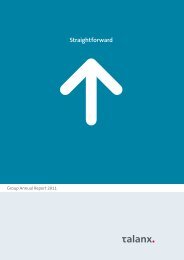Values
Values
Values
You also want an ePaper? Increase the reach of your titles
YUMPU automatically turns print PDFs into web optimized ePapers that Google loves.
100<br />
Group Financial Statements<br />
Notes<br />
Changes to estimates<br />
Random House determines the amount of the provision for<br />
returns by multiplying the gross revenues for the last twelve<br />
months, taking a return curve into account, with the average<br />
return rate. Th e proportion of the returns estimated but not yet<br />
received to gross revenues for each of the past twelve months<br />
is estimated by means the return curve.<br />
In 2009, Random House U.S. performed extensive investigations<br />
to ascertain whether the assumed twelve-month return<br />
curve is reasonable. Th e analyses were based on improved information<br />
on inventories at customers and on reviews within<br />
the division and customer surveys with regard to changes to<br />
return behavior. Based on these analyses, Random House North<br />
America cut the period for the return curve used in the calcula-<br />
tion from twelve to nine months. Th e change in the estimate<br />
led to an increase in EBIT of €23 million. Th is eff ect is carried<br />
under the item “Special items”.<br />
When determining the interest rate for discounting pension<br />
and similar obligations in the euro zone, corporate bonds<br />
with a long term were once again included as of December<br />
31, 2009, by the actuary. Th ese bonds had been disregarded as<br />
of December 31, 2008, due to the turbulence on the fi nancial<br />
markets. Th ereby, the applied interest rate increases. Without<br />
these eff ects, the actuarial gains in 2009 would have been<br />
€129 million lower.<br />
Bertelsmann Annual Report 2009
















